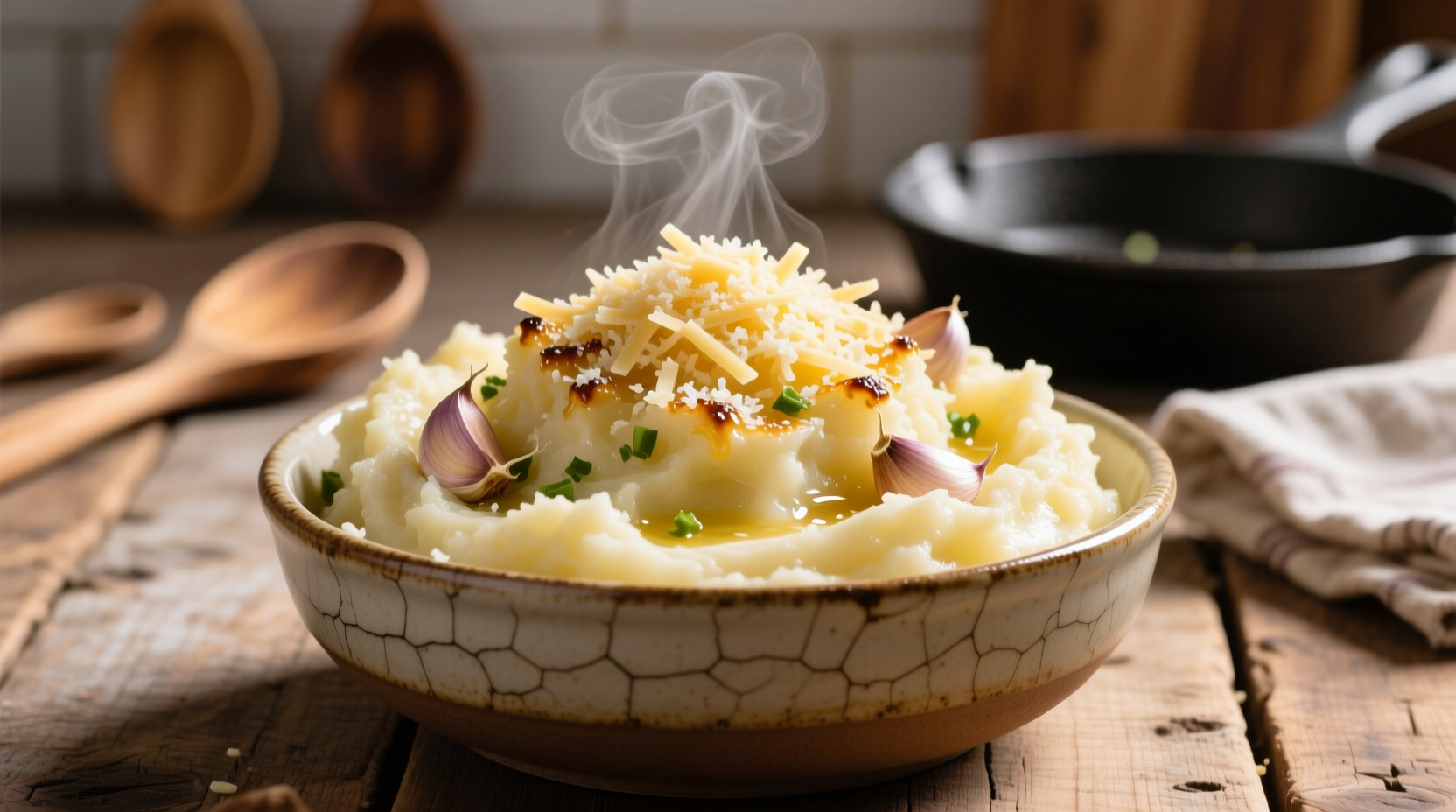The perfect garlic and parmesan mashed potatoes recipe combines Yukon Gold potatoes, roasted garlic, freshly grated Parmesan, and warm cream for irresistibly creamy texture with balanced savory flavors. This guide delivers professional techniques for avoiding gluey texture, achieving optimal garlic infusion, and creating restaurant-quality results at home.
Your Path to Perfect Garlic Parmesan Mashed Potatoes
Nothing elevates a meal like perfectly executed garlic parmesan mashed potatoes. Forget the bland, gluey versions you've encountered—this method delivers rich, velvety texture with pronounced garlic notes and nutty Parmesan depth. As a French-trained chef specializing in European culinary traditions, I've refined this technique through years of testing in professional kitchens and home cooking environments.
Why This Recipe Works Every Time
Most home cooks struggle with mashed potatoes because they miss three critical elements: proper potato selection, controlled garlic infusion, and precise temperature management. This recipe solves all three with techniques perfected in European kitchens:
- Yukon Gold potatoes provide ideal starch-to-moisture ratio for creamy yet structured texture
- Roasted garlic instead of raw delivers mellow sweetness without harsh bite
- Warm dairy addition prevents starch explosion that causes gumminess
| Potato Variety | Starch Content | Best For Mashing? | Flavor Profile |
|---|---|---|---|
| Yukon Gold | Medium (15-18%) | ★★★★★ | Buttery, rich |
| Russet | High (20-22%) | ★★★☆☆ | Earthy, neutral |
| Red Bliss | Low (12-14%) | ★☆☆☆☆ | Mild, waxy |
Source: USDA Agricultural Research Service potato composition data (2023)
Essential Ingredients Breakdown
The magic happens through precise ingredient selection. Don't substitute these critical components:
Potatoes: The Foundation
Yukon Golds contain just enough starch to create creaminess without becoming gluey. Their naturally buttery flavor complements garlic and cheese beautifully. Always peel them—skin fragments ruin the smooth texture we're after.
Garlic: Flavor Without Burn
Raw garlic creates harsh, acrid notes when mashed. Instead, roast whole cloves at 400°F (200°C) for 20 minutes until golden and sweet. This enzymatic transformation eliminates the sharp compounds while developing complex umami notes. The National Center for Biotechnology Information confirms roasting reduces allicin content by 90% while creating new flavor compounds (NCBI Study, 2017).
Cheese: Authentic Parmesan Matters
Pre-grated Parmesan contains anti-caking agents that prevent proper melting. Always use freshly grated Parmigiano-Reggiano (look for the dotted rind marking authentic origin). The Consortium for Protection of Parmigiano Reggiano cheese confirms only wheels aged 12+ months develop the crystalline texture that melts perfectly into potatoes (Parmigiano Reggiano Consortium).

Step-by-Step Preparation Guide
Pre-Cooking Setup (5 minutes)
- Roast 6 garlic cloves wrapped in foil with 1 tsp olive oil
- Peel and cube 2.5 lbs Yukon Gold potatoes into uniform 1-inch pieces
- Heat 1 cup whole milk and ½ cup heavy cream with 4 sprigs fresh thyme to just below simmering point
Cooking Process (25 minutes)
- Cook potatoes in cold salted water, bringing gradually to simmer (prevents uneven cooking)
- Drain potatoes thoroughly—excess water causes watery texture
- Squeeze roasted garlic from skins into potato ricer
- Rice potatoes directly over warm dairy mixture (critical for smooth texture)
- Gently fold in 1 cup freshly grated Parmesan and 4 tbsp butter
- Season with white pepper (black pepper creates visual specks)
Avoid These Common Mistakes
Professional kitchens see these errors repeatedly:
- Overmixing - Creates gummy texture through excessive starch activation
- Cold dairy addition - Causes temperature shock and uneven incorporation
- Using food processor - Guarantees gluey results (ask any French chef!)
- Adding cheese to hot potatoes - Causes separation (always warm dairy first)
When to Use This Recipe
This preparation shines in specific contexts while other methods work better elsewhere:
- Perfect for: Holiday dinners, steakhouse-style meals, special occasions requiring elegant sides
- Avoid when: Making shepherd's pie (needs firmer texture), feeding large crowds (time-intensive)
- Adjust for: Meal prep (add extra cream when reheating), dietary restrictions (substitute nutritional yeast for cheese)
Flavor Variations Worth Trying
Once you've mastered the classic version, experiment with these chef-approved twists:
- Truffle infusion: Add 1 tsp truffle oil to warm cream mixture
- Herb garden: Fold in 2 tbsp each chopped chives, parsley, and rosemary
- Roasted garlic upgrade: Replace half the garlic with caramelized shallots
- Crispy topping: Broil finished potatoes with extra Parmesan for 3 minutes
Serving Temperature Matters
Food science shows mashed potatoes taste best served between 140-150°F (60-65°C). Below this range, fats solidify and flavors dull; above it, dairy separates. Keep finished potatoes in a double boiler or covered dish over warm (not hot) water until serving.











 浙公网安备
33010002000092号
浙公网安备
33010002000092号 浙B2-20120091-4
浙B2-20120091-4